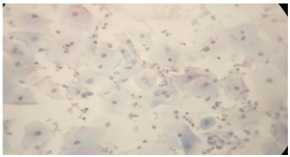Comparison of different methods of fixation in Papanicolaou staining of cervical smears: Wet-fixation and rehydration of air dried smears
Abstract
Introduction: Cervical cancer is a major cause of death in women in all over the world. Cytological screening by Papanicolaou (Pap) smear had reduced significantly the occurrence of invasive cervical cancer. Obtaining a properly stained smear is needed for correct diagnosis which is often not possible due to improper fixation and drying artefacts.
Objective: Our study tried to compare the morphology of the cervical smears fixed by two different fixation techniques, rehydration of air-dried smears (AD) versus wet fixation (WF).
Design: This is a cross sectional study conducted in the department of pathology, Sree Narayana institute of medical sciences, Ernakulum, Kerala.
Subjects: We collected cervical smears from three hundred patients in 24-72 years who attended our gynaecology department. Methods: Two slides are collected per patient. One of slides is immediately wet fixed in 95% ethanol (WF). The other slide was air dried and rehydrated for prior to routine staining by using glycerol saline rehydration method. Then the slides were stained by standard Papanicolaou method and paired slides were compared.
Result: Most of the patients (51%) included in the study belonged to 35- 45- years of age years, presented with complaints of discharge per vaginum. Air dried smears showed better cytoplasmic staining, distinct nuclear borders, clear background and low rate of cytolysis compared to wet fixed smears.
Conclusions: Because of many advantages compared to the conventional wet fixation, air dried smears can be used routinely or as an alternative in mass cervical cancer screening programmes
Downloads
References
2. Maitra A, Abbas AK. Robbins and Cotran- Pathologic Basis of Disease. 7th ed. New Delhi: Elsevier; 2004.The female genital system;p.1169-70.
3. Bancroft, J.O, A. Stevens. Theory and Practice of Histological Techniques. 2nd ed. Edinburgh: Churchill Livingstone:1982. P. 466.
4. Sivaraman G, Iyengar KR. Rehydrated air-dried Pap smears as an alternative to wet-fixed smears. Acta Cytol. 2002 Jul-Aug;46(4):713-7.
5. Gupta S, Sodhani P, Chachra KL. Rehydration of air-dried cervical smears: a feasible alternative to conventional wet fixation. Obstet Gynecol. 2003 Oct;102(4):761-4.
6. John k. c. chan, Ignatius T. Kung. Rehydration of Air-Dried Smears with Normal Saline. Application in Fine-Needle Aspiration Cytologic Examination. A.J.C.P. 1988 ; 89(1) :30-4
7. Koss, Leopold G, Melamed, Myron R. Koss Diagnostic Cytology and Its Histopathologic Bases. 5th ed. New york: Lippincott Williams and Wilkins;2006. Vol 1;p.1-20.
8. EARN AA. The clinical use of exfoliative utero-vaginal cytology. Can Med Assoc J. 1952 May;66(5):465-8.[pubmed]
9. Lampard-SH, Wilson S, Waddell C, Ryan A, Holder R, Kehoe S et al. Systemic review: Vaginal vault smears after hysterectomy for reasons other than malignancy: a systemic review of the literature. BJOG 2006;113:1354-1365.
10. Lowhagen T, Willems JS: General comments on aspiration biopsy cytology, Compendium on diagnostic cytology. 5th ed. Tutorials of Cytology, 1983. p 506-511.
11. Graham RM. The cytologic diagnosis of cancer. 2nd ed. Philadelphia: WB Saunders: 1964. p 343-344.
12. Lencioni LJ, Stafneri JJ, Cardonnet LJ. Vaginal and urinary sediment smear staining technique without previous fixation, adapted to Papanicolaou's and Shorr's staining methods. J Lab Clin Med 1954; 44:595-599.
13. Bonime RG. Air-dried smear for cytologic studies. Obstet Gynecol. 1966 Jun;27(6):783-90.[pubmed]
14. Bales CE, Durfee GR. Cytological techniques, Diagnostic cytology and its histopathologic basis. 3rd ed. Philadelphia: JB Lippincott; 1979. p 1187-1266.
15. Chan JK, Kung IT. Rehydration of air-dried smears with normal saline. Application in fine-needle aspiration cytologic examination. Am J Clin Pathol. 1988 Jan;89(1):30-4.[pubmed]
16. Shidham VB, Kampalath B, England J. Routine air drying of all smears prepared during fine needle aspiration and intraoperative cytology studies. An opportunity to practice a unified protocol offering the flexibility of choosing a variety of staining methods. Acta Cytol. 2001 Jan-Feb;45(1):60-8. DOI:10.1159/000327188.[pubmed]
17. Ng WF, Choi FB, Cheung LL, et al. Rehydration of air-dried smears with normal saline. Application in fluid cytology. Acta Cytol. 1994 Jan-Feb;38(1):56-64.[pubmed]
18. Shidham VB, Lindholm PF, Kajdacsy-Balla A, et al. Methods of cytologic smear preparation and fixation. Effect on the immunoreactivity of commonly used anticytokeratin antibody AE1/AE3. Acta Cytol. 2000 Nov-Dec;44(6):1015-22. DOI:10.1159/000328590.[pubmed]
19. Shidham VB, Chang CC, Rao RN, et al. Immunostaining of cytology smears: a comparative study to identify the most suitable method of smear preparation and fixation with reference to commonly used immunomarkers. Diagn Cytopathol. 2003 Oct;29(4):217-21. DOI:10.1002/dc.10364.[pubmed]



 OAI - Open Archives Initiative
OAI - Open Archives Initiative


